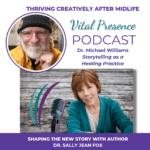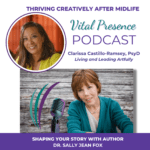 Lots of self help gurus preach that we can change what we believe (and then act) by changing how we think.
Lots of self help gurus preach that we can change what we believe (and then act) by changing how we think.
Powerful stuff, if we don’t forget one critical component: the body. Can we really think our way into change without listening to how the body feels about it?
The body stores feelings and the meanings we make from them. These meanings lead to our beliefs and then shape our reactions.
So when our boss puffs up her shoulders, frowns and looks at us directly in the eyes, our hearts start pounding, our guts twitch and we hear the warning bells: “Something terrible has happened….I did something…maybe I’m going to be fired!”
Even though we may know, rationally, that we have nothing to fear. The past meanings that influence our beliefs aren’t accurate today. But new information alone may not be sufficient to change them.
For change to really sink in, we need to talk to the body.
That’s why I was delighted to re-discover Focusing, a way of accessing your own innate bodily knowing.
My movement coach (thank you Karen Nelson!) sent me an invitation to a free 5-day on-line program that taught me the five key steps in Focusing (see below). The steps were elegantly distilled by Ann Weiser Cornell, based on the work of Dr. Eugene Gendlin, father of Focusing.
A bit about Focusing
Back in the ‘60’s Dr. Gendlin, working at university of Chicago wanted to know why some patients got better in therapy and others did not. Was there a particular magic in some therapists? Through extensive research he discovered that patients who improved the most showed some kind of experiential bodily awareness in their therapy sessions, along with cognitive insight. Those patients would veer away from their normal rational explanations, take a pause, and start searching for information through what they were experiencing – in their felt sense of their bodies.
Focusing’s been around since the 60’s. Yet I think it’s more timely than ever – not just in therapy but in all sorts of decision-making (read my experience below).
I don’t know about you – but I spend a lot of time in front of the computer thinking or writing. And during those times (I hate to admit this) I put my body “on-hold”.
Ann’s course offers me a way to gently check into my body and its wisdom and to un-do outdated meanings that I’m ready to change.
I liken our body’s knowing (at times) to a five year old kid in a shopping mall begging for his Mom’s attention and having a tantrum in order get it. “I’m not going anywhere until you LISTEN TO ME.”
Sometimes our bodies scream at us, too. We get sick. We can’t sleep. How often do we use casual body-centered observations like: “She’s a pain in the neck,” “I have a bad-feeling in my gut,” “He gives me a headache,” or the proverbial “Pain in the a…”
Our bodies are our early-warning systems and we can learn to sense into the information they have for us.
Lest I go on too long about body-centered knowing (a favorite topic), let me just share the following highlights from the the five steps Ann provided in her free program: Get Bigger Than What’s Bugging You.
Five Steps to Focusing
Step one: I start by saying “Something in me is feeling …”
I pause for a moment to notice what I am feeling and where the feeling is located in my body. As I witness what I’m feeling, something may already start to change. My witness self notices that my presence is bigger than just my feelings. I can observe them. And I’m not just one thing: I may be angry, sad, happy – all at the same time. I’m not one monolithic feeling.
Step two: I say “And I’m saying hello to it.”
We say hello to our friends and co-workers. Hello shows respect and shifts us into a place of respect and curiosity about our experience.
Step three: I place a gently hand on my body where the feeling lives.
I love touch, care, comfort and support – so I use my touch to show some tenderness towards my body and my feelings. With touch alone, really hard feelings may begin to melt.
Step four: I say, “I’m sensing something in me feels… ”
Now I describe the feeling. I may not know exactly what I am feeling, but I explore what I’m sensing and acknowledge whatever comes up. I may uncover information about my feelings, past meanings I’ve created, and old, divisive scripts that keep playing inside of me.
I don’t try to change the feelings. I allow them to be. I’m interested.
Step five: I use the phrase, “No wonder.”
With this phrase I show compassion for myself, my experiences, and for the feelings that I have, even if I don’t understand them. I defuse the shame of thinking I shouldn’t have certain feelings.
Do check out Ann’s program for a full description of the steps.
Here’s a very personal example of how a few minutes of Focusing changed my life.
I was having a major difference with my sister over my mother’s care as we struggled to deal with an emergency. Old, familiar, ugly emotions started stirring in my gut. I was feeling very reactive.
I begin step one: “Something in me is feeling angry. I notice where I feel tight, where my heart is beating fast, where my throat feels strained.
I take a pause and say (step two), “I’m saying hello to it”. I greet my tightness and angry feelings like a friend even though, frankly, I’m not feeling that friendly about being angry.
Step 3. I put my hand gently over my stomach and then over my chest. I breathe with the feelings and show some compassion to my body. As I breathe, the anger ratchets down a notch. I show some comforting tenderness to my hurting self, and start feeling less reactive. I breathe more and experience some love both for myself and for my sister.
Step 4. I say, “I am sensing that something in me feels” — and now the inquiry really starts. I look at where I’m hurting and discover anger, sadness and fear. I hear the old scripts that goes with the pain, yet I’m starting to recognize them as old scripts.
I keep listening, leaving my hand on my gut. Suddenly, I drop deeper within myself and feel the edges of the grief I carry, knowing that I’m going to lose my mother one of these days.
Step 5. I say, “No wonder.” Now it hits. I’m feeling the grief. My deepest pain is not about my sister, really. It’s about a tough, very human situation we’re both facing. I allow myself to cry and see how I am projecting on to my sister pains I haven’t wanted to acknowledge in myself.
Now, I’m filled with compassion – for myself, my sister, the situation. I’m ready to hear her point of view, because I’ve listened to my feelings, my body, and my own inner wisdom.
In our next phone call, something profound has shifted. We are both listening deeply – letting the love for each other and for my mother guide our actions. We come up with a mutual decision that seems really right in a difficult situation. And most beautifully, we come out of the experience closer to each other.
That’s all the proof I need that Focusing and accessing your body’s wisdom can change your life.
But do find out for yourself by trying Ann’s program and let me know what you discover.









